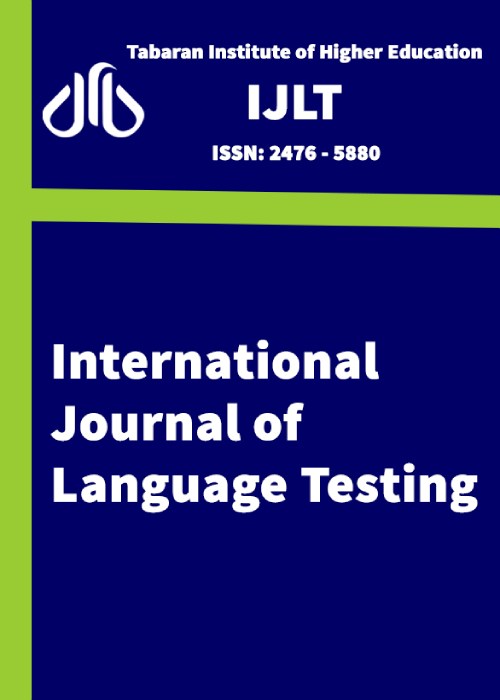فهرست مطالب
International Journal of Language Testing
Volume:5 Issue: 1, Mar 2015
- تاریخ انتشار: 1394/09/22
- تعداد عناوین: 4
-
Page 1The effect of testing on teaching and learning is commonly referred to as washback. It is mediated by factors which may be different from context to context. This study focused on school type and location assumed to be closely associated with the washback effect of the nationwide Iranian University Entrance Examination (UEE). To study the impact of the UEE on Iranian students at senior high schools, the researcher reviewed the existing instruments for washback studies and developed his own questionnaire which included 20 items on a six-point Likert scale. Five experts reviewed and assessed the instrument to determine its content and face validity. The internal consistency reliability of the questionnaire was. 72 based on Cronbach''s coefficient alpha. Stratified random sampling was used to select 120 freshmen from Kosar University of Bojnord (KUB). The questionnaire was given to the randomly-selected students. The descriptive statistics suggested that the majority of the surveyed students perceived the harmful effect of the UEE on their learning activities. However, the independent-samples t-test results indicated that there was no significant difference between students'' perceptions of the impact of the UEE in view of the school type or location in which they were studying.Keywords: The Concours, University Entrance Examination, Washback, Impact, EFL, Teaching, Learning
-
Page 29The distinction between psychometric and psychological unidimensionality is a very debatable issue in tests of psychological constructs including language ability tests. In the language testing literature, psychometric unidimensionality has been controversially found not to necessarily guarantee psychological unidimensionality and vice versa. This issue provided impetus for this study to see what the analysis of psychometric unidimensionality of writing reveals about its psychological unidimensionality from an a priori construct validity perspective. In this study, Principal Component Analysis, as a frequently used technique in language testing, was employed to investigate unidimensionality. The results of the analysis on a heterogeneous sample of writings by 135 EFL learners demonstrate that writing is both psychometrically and psychologically unidimensional only in terms of its linguistic rather than mechanical aspects; however, it does not mean that the mechanical aspects of writing should not be considered in assessing writing.Keywords: multi, dimensionality, principal component analysis, psychometric, psychological unidimensionality, writing skill
-
Page 46The traditional teaching of writing has been the predominant approach in many schools around the world. Second/foreign language (L2) students‟ writing attempts have been usually assessed by means of a single final exam as the main criterion representative of their writing ability. Recently, however, there has been a shift from the dominant past paradigm to using portfolios as a possible means of language learning and assessment. This study examined the effectiveness of portfolio assessment in L2 learners‟ expository writing ability. A quasi-experimental research design was employed; two writing classes, including 44 undergraduate EFL students in two universities, constituted the control and experimental groups and expository writing tasks were administered as the pretests and posttests. The control group was instructed through the traditional approach of learning and assessment whereas the experimental group was provided with a portfolio assessment practice. The results of covariance analysis and t-tests indicated that the participants in the experimental group outperformed the ones in the control group in terms of their expository writing ability, in general, and the subskills of focus, support, and organization in particular. But, the performance of the two groups in the subskills of vocabulary and convention in writing was not significantly different.Keywords: portfolio assessment, L2 learning, expository writing
-
Page 60The purpose of the present study was to investigate the effect of different quiz frequencies on Iranian EFL learners'' comprehension and production of English idioms. Furthermore, the study compared students'' attitudes toward frequent quizzes before and after the course and also investigated their opinions as to the most popular quiz frequency in the comprehension and production of idioms. To this end, 120 male and female language learners at intermediate level of proficiency were selected in four groups. Each group was randomly assigned to one of the treatment conditions. The first group received quizzes every week; the second group received quizzes biweekly; the third group was administered a quiz once a month; and the fourth group (the comparison group) received no quiz during the instructional period. The collected data were analyzed using two oneway ANOVAs, three Wilcoxon signed ranks tests, and two Chi-squares. The results of ANOVAs indicated that frequent quizzes had a significant effect on the comprehension and production of English idioms. The results of the Wilcoxon signed ranks tests revealed that the participants'' attitudes changed positively towards frequent testing in general and its effect on the comprehension and production of idioms in particular. The results of the Chi-squares revealed that bi-weekly quizzing was the most popular quizzing frequency both in the comprehension and production of idioms. The findings of the present study may have implication for teachers, learners as well as syllabus designers.Keywords: idiom, idiom comprehension, idiom production, frequent quizzes


